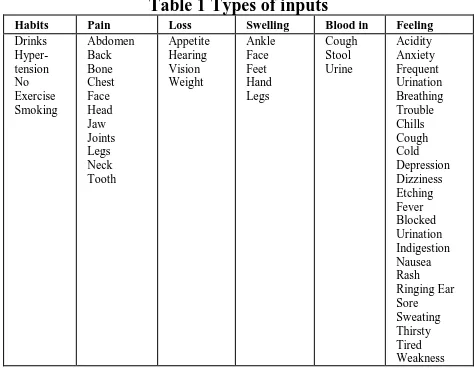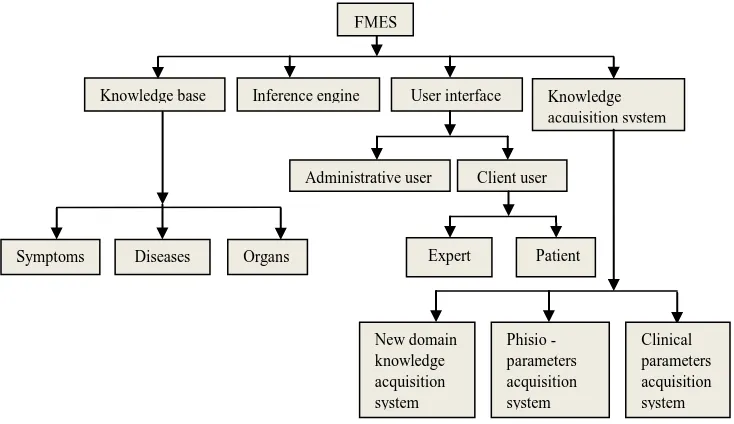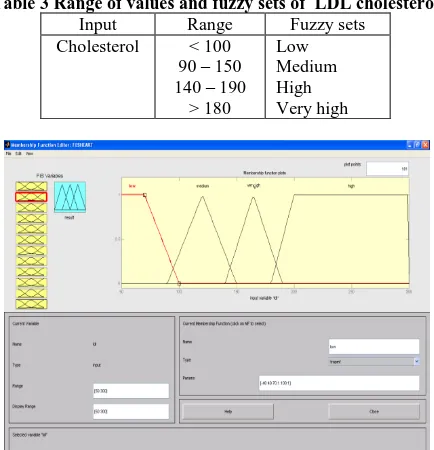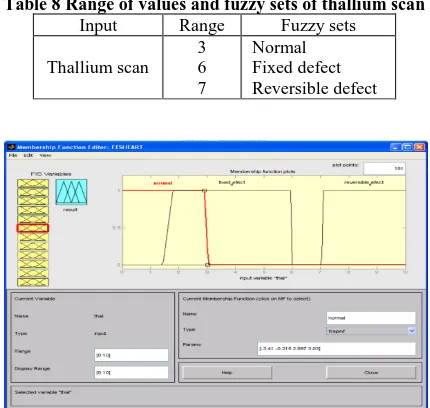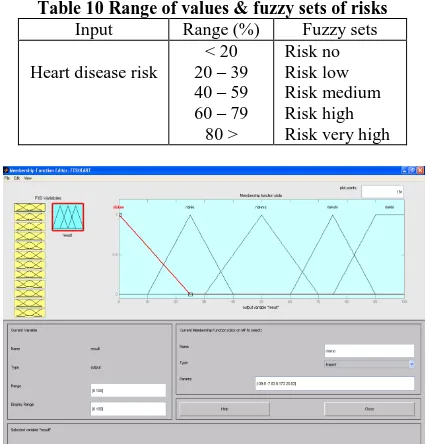Generic Medical Fuzzy Expert System for Diagnosis of
Cardiac Diseases
Smita Sushil Sikchi
Prof. Ram Meghe Institute of Technology & Research,
Badnera-Amravati, India
Sushil Sikchi
Department of Radiology, Punjabrao Deshmukh Memorial Medical College, Amravati, India
Ali M. S.
Prof. Ram Meghe College of Engineering & Management,
Badnera-Amravati, India
ABSTRACT
The logical thinking of medical practitioners play significant role in decision making about diagnosis and exhibit variation in decisions because of their approaches to deal with uncertainties and vagueness in the knowledge and information. Fuzzy logic has proved to be the remarkable tool for building intelligent decision making systems for approximate reasoning that can appropriately handle both the uncertainty and imprecision. The attempt has been made to explore the capabilities and potentialities of fuzzy expert systems for the emulation of thought in a much more general sense although confined to medical diagnosis. Generic medical fuzzy expert system for diagnosis of cardiac diseases is designed. Mathematical model is developed to predict the risk of heart disease and to compare with the performance of fuzzy expert system. Reported the user friendly decision support system developed for medical practitioners as well as patients. A mathematical model is developed to justify performance of fuzzy expert system.
Keywords
Fuzzy expert system, generic framework, medical diagnosis, risk predictive model
1.
INTRODUCTION
The diagnostic decision depends upon experience, expertise and perception of the medical practitioner. Fuzzy logic presents powerful reasoning methods that can handle uncertainties and vagueness. The Fuzzy Expert Systems (FES) define imprecise knowledge and offers linguistic concept with excellent approximation to medical texts.2 Fuzzy logic is a method to render precise what is imprecise in the world of medicine. FES play an important role in medicine for symptomatic diagnostic remedies. The technocrats identified potential and possible areas for implementation of FES for medical diagnosis. Also, the efforts have been made by various researchers to establish a roadmap to forecast the future developments of expert systems in medical diagnosis. The computer based diagnostic tools and knowledge base certainly helps for early diagnosis of diseases. The development of web based applications and interfaces enabled the medical practitioners to share their experiences and expertise across the world. In review of the literature concerned with fuzzy expert systems applied to medical domain, it appears that there is a need for common framework that can be used for development of fuzzy expert system for any medical domain. The aim of this paper is to report the generic fuzzy expert system model that can be used to design specific fuzzy expert system for particular medical domain. An example of cardiac disease diagnosis is illustrated in support to describe the concept. The literature review reveals that the mathematical model developed is the pioneer attempt
to predict the risk of heart disease and used to compare the performance of fuzzy expert system.
2.
REVIEW OF LITERATURE
36 frameworks are developed and utilized so far for the tasks of
quantifying medical concepts, data interpretation and constructing inferential knowledge from the knowledge bases.
3.
PROPOSED ARCHITECTURE OF
GENERIC FUZZY EXPERT SYSTEM
FOR MEDICAL DIAGNOSIS
The modeling of any fuzzy expert system generally comprises the following steps:
(i) Selection of relevant input and output parameters (ii) Choosing of appropriate membership functions, fuzzy
operators, reasoning mechanisms and
(iii) Choosing of specific type of fuzzy inference system (iv) Formulation of rule base
Figure 1 represents the architecture of a proposed generic fuzzy expert system showing the flow of data through the system. It consists of mainly GUI, knowledge acquisition, knowledge base and inference engine modules. The fuzzy expert system being generic, its GUI module offers user to populate the knowledge base as and when required. User can refer and select the relevant clinical parameters and symptoms from the knowledge base to converge to the inference. The knowledge acquisition module allows user to seek the inputs as well as to build the new domain knowledge. The input variables are fuzzified whereby the membership functions defined on the input variables are applied to their actual values, to determine the degree of truth for each rule antecedent. The fuzzy rule base is characterized in the form of if-then rules in which the antecedents and consequents involve linguistic variables. The truth value for the antecedent of each rule is identified and applied to the consequent part of each rule. This results in one fuzzy subset to be assigned to each output variable for each rule. By using suitable aggregation procedure, all the fuzzy subsets assigned to each output variable are combined together to form a single fuzzy subset for each output variable. Finally, defuzzification is applied to convert the fuzzy output set to a crisp output. The basic fuzzy inference system can take either fuzzy inputs or crisp inputs, but the outputs it produces are always fuzzy sets. The defuzzification task extracts the crisp output that best represents the fuzzy set. With crisp inputs and outputs, a fuzzy inference system implements a nonlinear mapping from its input space to output space through a number of fuzzy ‘if-then’rules. Figure 2 represents the elements of fuzzy expert system showing hierarchy of various modules in the application.
4.
DESIGN OF GENERIC FUZZY
EXPERT SYSTEM FOR CARDIAC
DISEASES DIAGNOSIS
[image:2.595.309.546.375.559.2]The generic fuzzy expert system consists of a smart user interface that enables user to select the appropriate symptoms. The system accepts physiological inputs specific to the patients as shown in Figure 3. The system also accepts the laboratory readings, electrocardiogram observations and x-ray observations. Table 1 shows the types of inputs the fuzzy expert system accepts. Figure 4 shows the form designed for knowledge base modification and rules generator mechanism. Figure 5 shows the form for selection of clinical parameters and symptoms. The MatLab fuzzy logic toolbox was used to simulate the medical diagnosis application. The input variables considered are age, blood pressure, cholesterol, heart rate, blood sugar, sex, ECG, old peak and the thallium scan. Membership values are assigned to the linguistic variables such as symptoms low, medium, high, very high. The patient data is stored in a database and knowledge is retrieved from the knowledge base by matching the symptoms and their severity against the antecedent part of fuzzy rules in knowledge base to make the decision as the disease name or the risk of the disease. The fuzzy decision value is defuzzified by the defuzzification component of the designed system to finally arrive at a crisp decision for the disease diagnosis. The output parameter considered is the presence of heart disease in patient. Membership functions of all the input and output parameters are designed.
Table 1 Types of inputs
Habits Pain Loss Swelling Blood in Feeling
Fig 1: Architecture of proposed generic fuzzy expert system
Fig 2: Hierarchy of elements of fuzzy expert system
USERS
KNOWLEDGE BASE
KNOWLEDGE ACQUISITION
Expert Patient Admin
user ORGANS
DISEASES
SYMPTOMS
Information Guidelines
Fuzzification
Intelligence
New Domain Knowledge
Physio -Parameters
Clinical Parameters
Defuzzification
Inference Engine User Interface
Database
FMES
Knowledge base Inference engine User interface Knowledge acquisition system
Administrative user Client user
Expert Patient Symptoms Diseases Organs
New domain knowledge acquisition system
Phisio -parameters acquisition system
[image:3.595.97.464.411.623.2]38 Fig 3: Selection of physiological parameters and symptoms
[image:4.595.64.271.299.486.2]Fig 4: Parameters editing and rules generation
Fig 5: Selection of clinical parameters and symptoms
4.1 Membership Functions of Systolic Blood Pressure Blood pressure is one of the most significant parameter in heart disease. Any blood pressure greater than or equal to 140 systolic and 90 diastolic is considered as high blood pressure. Here, the blood pressure input parameter range is divided into
four fuzzy sets, namely, ‘low’, ‘medium’, ‘high’ and ‘very high’. The range of values and respective fuzzy sets of blood pressure is given in Table 2. The membership functions of fuzzy sets of blood pressure are of triangular and trapezoidal types as shown in Figure 6. The fuzzy membership expression for this input parameter is represented by Equation (1).
Table 2 Range of values and fuzzy sets of systolic blood pressure
Input Range Fuzzy sets
Systolic blood pressure
<140 Low
120-160 Medium
140-180 High
[image:4.595.337.527.431.662.2]>160 Very High
Fig 6: Membership functions of systolic blood pressure
ρlow (x) =
ρmedium (x) =
ρhigh (x) =
ρveryhigh (x) = (1)
4.2 Membership Functions of Cholesterol
The presence of too much low-density lipoprotein, i.e. LDL cholesterol in body carries a major risk for heart disease. Here, the cholesterol parameter range is divided into four fuzzy sets, namely, ‘low’, ‘medium’, ‘high’ and ‘very high’. The range of values and respective fuzzy sets of cholesterol is given in Table 2. The membership functions of fuzzy sets of cholesterol are of triangular and trapezoidal types as shown in Figure 7. The fuzzy membership expression for this input parameter is represented by Equation (2).
x – 120 120 ≤ x < 140 20
1 x = 140 160 – x 140 ≤ x < 160 20
x – 140 140 ≤ x < 160 20
1 x = 160 180 – x 160 ≤ x < 180 20
x – 160 160 < x < 180 20
[image:4.595.57.279.522.669.2]39 Table 3 Range of values and fuzzy sets of LDL cholesterol
Input Range Fuzzy sets
Cholesterol < 100 90 – 150 140 – 190
> 180
[image:5.595.59.276.76.301.2]Low Medium High Very high
Fig 7: Membership functions of cholesterol
ρlow (x) =
ρmedium (x) =
ρhigh (x) =
ρveryhigh (x) =
(2) 4.3 Membership Functions of Electrocardiography Electrocardiogram (ECG) is a test that measures the electrical activity of the heart. It uses ultrasound to evaluate heart muscle, heart valves, and risk for the heart disease. An electrocardiogram records problem with the heart's rhythm and the conduction of the heart beat through the heart. Here, the ECG parameter range is divided into three fuzzy sets, namely, ‘Normal’, ‘ST-T Normal’ and ‘Hypertrophy’. The range of values and respective fuzzy sets of ECG is given in Table 4. The membership functions of fuzzy sets of ECG are of triangular and trapezoidal types as shown in Figure 8. The fuzzy membership expression for this input parameter is represented by Equation (3).
Table 4 Range of values and fuzzy sets of electrocardiography
Input Range Fuzzy sets
Resting Electrocardiography
[-0.5, 0.4] [0.25, 1.8]
[1.4, 2.8]
Normal ST - T abnormal Hypertrophy
Fig 8: Membership functions of electrocardiography
4.4 Membership Functions of Heart Rate
Heart rate is how many times heart beats in one minute. The average resting heart rate ranges from 60 to 100 beats per minute. Heart rate increases linearly with the extent of exercise and determines the cardiorespiratory fitness of a man. Here, the heart rate parameter range is divided into three fuzzy sets, namely, ‘low’, ‘medium’ and ‘high’. The range of values and respective fuzzy sets of heart rate is given in Table 5. The membership functions of fuzzy sets of heart rate are of triangular and trapezoidal types as shown in Figure 9. The fuzzy membership expression for this input parameter is represented by Equation (4).
Table 5 Range of values and fuzzy sets of heart rate
Input Range Fuzzy sets
Maximum heart rate
< 100 90 – 150
140 >
[image:5.595.74.262.325.534.2]Low Medium High
Fig 9: Membership functions of heart rate
ρlow (x) =
ρmedium (x) =
ρhigh (x) =
(4) 1 x < 70
100 – x 70 ≤ x < 100 30
x – 90 90 ≤ x < 120 30
1 x = 120 150 – x 120 ≤ x < 150 30
x – 140 140 ≤ x < 165 25
1 x = 165 190 – x 165 ≤ x < 190 25
x – 180 180 ≤ x < 240 60
1 x ≥ 240
1 x < 80 100 – x 80 ≤ x < 100 20
x – 90 90 ≤ x < 120 30
1 x = 120 150 – x 120 ≤ x < 150 30
x – 140 140 ≤ x < 180 40
[image:5.595.326.532.395.601.2]40 4.5 Membership Function of Fasting Blood Sugar
[image:6.595.324.536.71.217.2]The blood sugar levels could affect the risk of coronary heart disease in both diabetics and non-diabetics. Here, the heart rate parameter range is divided into two fuzzy sets, namely, ‘Non diabetic’ and ‘diabetic’. The range of values and respective fuzzy sets of blood sugar is given in Table 6. The membership functions of fuzzy sets of blood sugar are of trapezoidal types as shown in Figure 10. The fuzzy membership expression for this input parameter is represented by Equation (5).
Table 6 Range of values & fuzzy sets of blood sugar
Input Range Fuzzy sets
Fasting blood sugar
≤ 120 120 >
[image:6.595.57.278.191.381.2]Non diabetic Diabetic
Fig 10: Membership functions of fasting blood sugar
ρveryhigh (x) = (5)
4.6 Membership Functions of an Old Peak
The old peak is ST-depression induced by exercise relative to rest. A quantitative assessment of the level of ST segment depression during exercise is of additional value to assess prognosis and to measure the efficacy of disease. Here, the old peak parameter range is divided into three fuzzy sets, namely, ‘Low’, ‘Risk’ and ‘Terrible’. The range of values and respective fuzzy sets of old peak is given in Table 7. The membership functions of fuzzy sets of old peak are of triangular and trapezoidal types as shown in Figure 11. The fuzzy membership expression for this input parameter is represented by Equation (6).
Table 7 Range of values and fuzzy sets of old peak
Input Range Fuzzy sets
Old peak
< 2 1.5 – 4.2
2.55 > Low Risk Terrible
Fig 11: Membership functions of old peak
ρlow (x) =
ρrisk (x) =
ρterrible (x) =
(6) 4.7 Membership Functions of a Thallium Scan
[image:6.595.318.509.250.401.2]A thallium scan is a test that uses a radioactive substance to produce images of the heart muscles. The thallium scan helps determine if areas of the heart do not receive enough blood. Here, the thallium scan parameter range is divided into three fuzzy sets, namely, ‘Normal’, ‘Fixed defect’ and ‘Reversible defect’. The range of values and respective fuzzy sets of thallium scan is given in Table 8. The membership functions of fuzzy sets of age are trapezoidal types as shown in Figure 12.
Table 8 Range of values and fuzzy sets of thallium scan
Input Range Fuzzy sets
Thallium scan 3 6 7
[image:6.595.65.268.412.452.2]Normal Fixed defect Reversible defect
Fig 12: Membership functions of thallium x – 105 105 ≤ x < 120
15
1 x ≥ 120
1 x < 1 2 – x 1 ≤ x < 2 1
x – 1.5 1.5 ≤ x < 2.8 1.3
1 x = 2.8 4.2 – x 2.8 ≤ x < 4.2 1.4
x – 2.55 2.55 ≤ x < 4 1.45
[image:6.595.321.536.532.736.2]4.8 Membership Functions of Age
[image:7.595.63.272.166.638.2]With the increase in age of a man, the chances of developing heart disease increases. Here, the age parameter range is divided into four fuzzy sets, namely, ‘Young’, ‘Adult’, ‘Old’ and ‘very old’. The range of values and respective fuzzy sets of age is given in Table 9. The membership functions of fuzzy sets of age are of triangular and trapezoidal types as shown in Figure 13. The fuzzy membership expression for this input parameter is represented by Equation (8).
Table 9 Range of values and fuzzy sets of age
Input Range Fuzzy sets
Age
< 38 31 – 45 41 – 60 > 56
Young Adult Old Very old
Fig 13: Membership functions of age
ρyoung (x) =
ρadult (x) =
ρold (x) =
ρveryold (x) =
(8)
4.9 Inference Mechanism and System Output
In this system, more than one thousand fuzzy rules pertaining to the heart disease are formed. The output shows the presence or absence of risk for heart disease subjected to given the values of input parameters. The rules are formulated using Matlab rule editor. The rules consist of antecedent and consequent parts. All the rules fire to some extent in the antecedent part of the fuzzy system. In the inference process, the truth value for the premise of each rule is computed, and applied to the conclusion part of each rule. This results in one fuzzy subset to be assigned to each output variable for each
[image:7.595.322.535.394.616.2]rule. The fuzzy expert system computes the probabilities and determines output value in terms of percentage of the risk of heart disease from zero percent to hundred percent. The risk value is divided into five fuzzy sets, namely, ‘Risk no’, ‘Risk low’, ‘Risk medium’, ‘Risk high’ and ‘Risk Very high’. The range of values and respective fuzzy sets of output is given in Table 10. The membership functions of fuzzy sets of output are of triangular and trapezoidal types as shown in Figure 14. Figure 15 and Figure 16 represents the rule viewer and rule surface viewer respectively in MatLab fuzzy tool box. Figure 17 shows the rule editor in Matlab fuzzy tool box. The Rule Viewer allows interpreting the entire fuzzy inference process at once. Each column of plot in Figure 15 shows how the input variable is used in the rules. Each rule is a row of plots and each column is a variable. The menu items allow user entering input values. The last column of plots shows how the output variable is used in the rules. Each row of plots represents one rule. The bottom-right plot shows how the output of each rule is combined to make an aggregate output and then defuzzified. The blank plot corresponds to the characterization of none for the corresponding variable in the rule. The thick vertical line in plot represents the aggregate weighted decision for the given inference system. This decision will depend on the input values for the system. The defuzzification of fuzzy sets is performed to convert aggregation result into crisp value of the output using centroid method. The defuzzified output value is shown by the thick line passing through the aggregate fuzzy set. The Surface Viewer generates a three-dimensional output surface where any two of the inputs can be varied.
Table 10 Range of values & fuzzy sets of risks
Input Range (%) Fuzzy sets
Heart disease risk
< 20 20 – 39 40 – 59 60 – 79 80 >
Risk no Risk low Risk medium Risk high Risk very high
Fig 14: Membership functions of heart disease risk x – 52 52 ≤ x < 60
8
1 x ≥ 60 1 x < 25 38 – x 25 ≤ x < 38 13
x – 41 41 ≤ x < 45 8
1 x = 45
60 – x 45 ≤ x < 60 15
x – 31 31 ≤ x < 38 7
42 Fig 15 : Rule viewer in MatLab fuzzy tool box
Fig 16: Rule surface viewer in MatLab fuzzy tool box
Fig 17: Rule editor in MatLab fuzzy tool box
5. FORMULATION OF MODEL
The mathematical model has been formulated to compute the risk of heart disease. In the medical diagnosis pertaining to heart diseases, the most influencing clinical parameters are age, blood pressure, lipid profile, heart rate and peak. The other parameters are many but those are comparatively less influencing. Mathematical model is developed to study the impact of most influencing parameters responsible for causing the heart disease and compare with the results obtained by fuzzy expert system. For the formulation of mathematical model, the risk of heart disease is considered as dependent parameter and age, blood pressure, cholesterol, heart rate and peak as the independent parameters. Considering the most significant parameters causing heart diseases, the risk determining relation can be established as follows :
Rh = f (age, bp, ldl, hr, pk)
where, Rh = Risk of heart disease in %
age = age
bp = blood pressure,
ldl = cholesterol
hr = heart rate
pk = peak
A probable exact mathematical form for computing the risk of heart disease (Rh), using regression analysis to find out the
best fit mathematical model suitable for the recorded data points, could be represented by Equation 9 :
Rh = k * agea * bpb * ldlc * hrd * pkd (9)
There are 6 unknown terms in Equation (9), viz. curve fitting constant, k and the indices a, b, c, d and e. To get the values of these unknowns we need five sets of values of age, bp, ldl, hr
and pk. The best-fit mathematical model has been formulated
using Gauss-Jordon method for solution of simultaneous equations and data given in Table 11. It also shows the risk values computed using mathematical model. Relationship for risk of heart disease (Rh) is represented by Equation (10) :
Rh = 0.000018 * age0.23 * bp0.97 * ldl1.25 * hr-0.22 * pk0.09
[image:8.595.62.277.124.519.2](10) It has been observed that, the above mathematical model is justifiable and may be used with a confidence for determining the risk of heart disease. The characteristic showing relationships between observed and computed values of disease risk is represented in Figure 17. An excellent co-efficient of correlation, (R2) values, 0.906 is yielded for observed and computed values using this mathematical model. The model is found justifiable as a unique tool for computation of the risk pertaining to heart disease. The formulated risk model is applicable for all types of input parameters to determine the risk. This model may be used with confidence for predicting the risk of apparently all heart related diseases.
[image:8.595.317.540.424.524.2]Fig 17: Graph between risk computed using MFES and mathematical model
Table 11 Parameters showing risk computed using MFES and mathematical model
Age BP LDL HR Peak
Risk computed by MFES
Risk using math model
71 120 265 130 0.24 40 32
49 130 188 139 2 40 28
54 135 129 126 0.1 10 8
59 140 187 152 0.1 20 17
57 128 229 150 0.14 40 24
61 122 260 170 3.6 60 53
39 165 219 150 1.2 60 48
61 145 277 186 1 60 61
56 125 249 144 1.2 40 41
45 130 164 135 0.16 20 13
56 190 288 153 4 100 121
y = 0.9987x R² = 0.9064
0 50 100 150
[image:8.595.314.543.506.763.2]54 160 239 146 1.8 60 57
41 120 200 130 0.1 20 16
61 124 209 163 0.1 20 18
58 120 258 137 0.14 20 28
51 122 227 124 0.1 20 21
29 130 204 202 0.1 20 20
51 140 241 186 0.1 20 29
43 122 213 165 0.12 20 20
57 167 299 164 1 80 85
6. CONCLUSION
The architecture of generic system has been proposed and designed the fuzzy expert system for medical diagnosis using visual basic and fuzzy logic tool box of MatLab software. The fuzzy expert system that is developed in visual basic and MatLab fuzzy tool box are interfaced. A strong knowledge base and rule base comprising more than 1000 rules exclusively pertaining to heart disease is the main backbone of the system. The system is of predictive type and very effective for the diagnosis of diseases related with heart, liver, lung, kidney, abdomen, bladder, brain, prostate, eyes and ears. The illustrative example is presented specific to heart disease diagnosis. The system accepts inputs in the form of physiological, radiological and clinical parameters from the user. Moreover, the user can select general as well as specific symptoms from the prebuilt symptoms library. The fuzzy expert system consists of rules generator mechanism and mechanism to update the knowledge base. The application has been tested and implemented successfully. The mathematical model is formulated to compute the risk of heart disease and compare the results obtained by fuzzy expert system. The model is found to be justifiable and excellent coefficient of correlation value has been observed. The model is found justifiable as a unique tool for computation of the risk pertaining to heart disease.
10. REFERENCES
[1] Abraham A. 2005. Rule-based Expert Systems. Handbook of Measuring System Design, John Wiley & Sons, 909-919.
[2] Adlassnig, K.P., Kolarz, G., Scheithauer, W. 1985. Present State of the Medical Expert System CADIAG-2. Methods of Information in Medicine, 24: 13-20.
[3] Ahmed, A., Bigand, A., Lethuc, V., Allious, P.M. 2004. Visual Acuity of Vision Tested by Fuzzy Logic: An Application in Ophthalmology as a Step Towards a Telemedicine Project. Information Fusion, 5:217-230. [4] Ali, Z., Singh, V., (2010). Potentials of Fuzzy Logic: An
Approach To Handle Imprecise Data. American Medical Informatics Association, 2, 4: 358-361.
[5] Ameri, A., Moshtaghi H., Design and Development of an Expert System in Differential Diagnosis of Maxillofacial Radio-lucent Lesions. Web URL, http://www.idt.mdh.se/ kurser/ct3340/archives/ht08/papersRM08/21.pdf.
[6] Aruna P., Puviarasan N., Palaniappan B. 2005. An Investigation of Neuro-Fuzzy System in Psychosomatic Disorders. Expert Systems with Applications, 28: 673-679.
[7] Asghar, M.Z., Khan, A.R., Asghar, M.J. 2009. Computer Assisted Diagnoses For Red Eye (CADRE). Int. J. of Compouter Science & Engineering, 1, 3: 163-170. [8] Banerjee, A., Majumdar, A.K., Basu, A. 1994. A Fuzzy
Expert System Approach Using Multiple Experts for Dynamic Follo-up of Endemic Diseases. Sadhana, India, 19, 1: 51-73.
[9] Berman, L., Cullen, M.R., Miller, P.L. 1992. Automated Integration of External Databases : A Knowledge-Based Approach to Enhancing Rule-Based Expert Systems. Proc. Annu Symp Comput Appl Med Care. 227-233. [10] Binaghi, E., Gallo, I., Ghiselli, C., Levrini, L., Biondi, K.
2008. An Integrated Fuzzy Logic And Web-Based Framework For Active Protocol Support. International Journal of Medical Informatics, 77: 256-271.
[11] Boegl, K., Adlassnig, K.P., Hayashi, Y., Rothenfluh, T.E., Leitich, H. 2004. Knowledge Acquisition in the Fuzzy Knowledge Representation Framework of a Medical Consultation System. Artificial Intelligence in Medicine. 30: 1-26.
[12] Chu, W.H. 1988. Generic Expert System Shell For Diagnostic Reasoning. Proc. of 1st Int. Conf. on Industrial and engineering applications of artificial intelligence & expert systems, NY, 1: 7-12.
[13] Ciabattoni, A., Vetterlein, T., Adlassnig, K. 2009. A Formal Logical Framework for Cadiag-2. Studies in Health Technology & Informatics, 150: 648-652. [14] Engle, R.L., Flehinger, B.J. 1987. Why Expert Systems
for Medical Diagnosis are not being generally used: A valedictory opinion. Bulletin of the New York Academy of Medicine, 63, 2: 193-198.
[15] Farshchi, S.M.R., Yaghoobi, M. 2011. Fuzzy Logic Expert Systems in Hospital : A Foundation View. Journal of Applied Sciences, 1-5.
[16] Isik, H., Arslan, S., (2011), “The Design of Ultrasonic Therapy Device via Fuzzy Logic”, Expert Systems with Applications, 38, pp 7342-7348.
[17] Jung, I., Wang, G. 2007. User Pattern Learning Algorithm based MDSS (Medical Decision Support System) Framework under Ubiquitous. World Academy of Science, Engineering and Technology, 36: 184-188. [18] Kerdprasop, N., Kerdprasop, K. 2011. Higher Order
Programming to Mine Knowledge for a Modern Medical Expert System. Int. J. of Computer Science, 8, 3: 64-72. [19] Lin, F., Ying, H., MacArthur, R.D., Cohn, J.A., Jones,
D.B., Crane, L.R. 2007. Decision Making in Fuzzy Discrete Event Systems. Information Sciences, 177:3749-3763.
44 [21] Muino, D.P., A Probabilistic Interpretation of the
Medical Expert System CADIAG-2. Web URL, http:// www.logic.at/WWTF016/PaperCadiag2Probability.pdf. [22] Owaied, H.H., Qasem, M.M. 2010. Developing
Rule-Case-Based Shell Expert System. Proc. of Int. Multi Conf. of Engineers and Scientists, 1.
[23] Pan, J., DeSouza, G.N., Kak, A.C. 1998. Fuzzy Shell : A Large-Scale Expert System Shell Using Fuzzy Logic for Uncertainty Reasoning. IEEE Transactions on Fuzzy Systems, 6, 4: 563-68.
[24] Pereira, JCR, Tonelli, P.A., Barros, L.C., Ortega, N.R.S. 2002. Defuzzification in Medical Diagnosis. Advances in Logic, Artificial Intelligence & Robotics. 202-207. [25] Qu, Y., Fu, T., Qiu, H. 2008. A Fuzzy Expert System
Framework Using Object Oriented Techniques. IEEE Pacific Asia Workshop on Computational Intelligence and Industrial Applications, 2: 474-477.
[26] Seising, R. 2004. A History of Medical Diagnosis Using Fuzzy Relations. Fuzziness in Finland'04, 1-5.
[27] Snae, C., Brueckner, M. 2008. Personal Health Assistance Service Expert System. World Academy of Science, Engineering and Technology : A Biological & Biomedical Sciences, 4, 2: 109-112.
[28] Tomar, P.P., Saxena, P.K. 2011. Architecture For Medical Diagnosis Using Rule-Based Technique. First Int. Conf. on Interdisciplinary Research & Development, Thailand, 25.1-25.5.
[29] Tsipouras, M.G., Voglis, C., Fotiadis, D.I. 2007. A Framework for Fuzzy Expert System Creation - Application to Cardiovascular Diseases. IEEE Transactions Biomedical Engg., 54, 11: 2089-2105. [30] Vetterlein, T., Ciabattoni, A. 2010. On the (fuzzy)
Logical Content of CADIAG-2. Fuzzy Sets and Systems, 161, 1941-1958.
[31] Wain, R.A., Tuhrim, S., D'Autrechy, L., Reggia, J.A. 1992. The Design and Automated Testing of an Expert System for the Differential Diagnosis of Acute Stroke. American Medical Informatics Association, 94-98. [32] Zahan, S. 2001. A Fuzzy Approach to
Computer-Assisted Myocardial Ischemia Diagnosis. Artificial Intelligence in Medicine, 2, 271-275.
